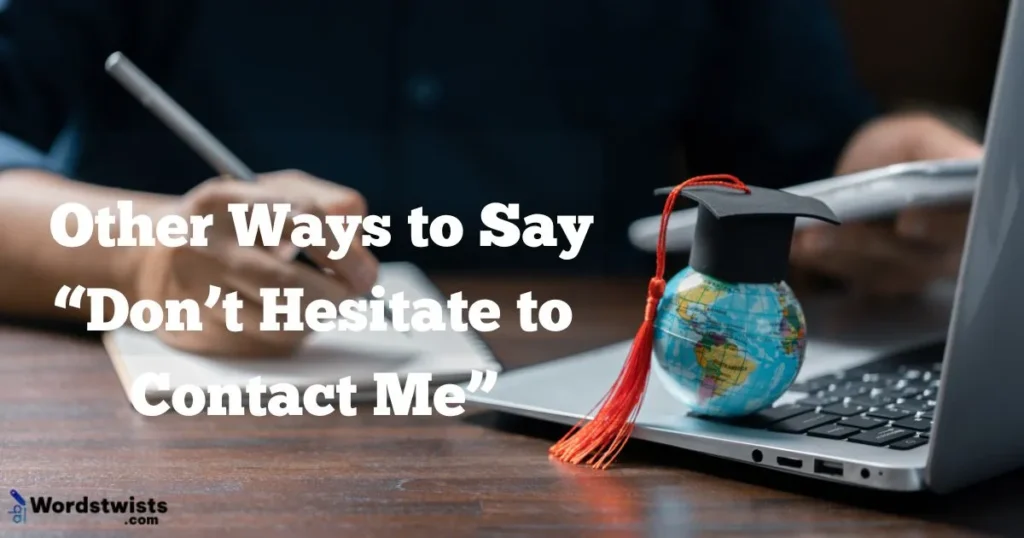We’ve all seen—and maybe used—the phrase “Don’t hesitate to contact me” in emails, messages, and customer service conversations. It’s a polite way to invite someone to reach out, but let’s be honest: after a while, it can feel a little overused and even a bit robotic. If you want to sound more genuine, approachable, and fresh, it’s time to mix it up.
That’s why I’ve put together 25 creative alternatives to “Don’t hesitate to contact me” that will help you express your willingness to connect in a way that feels natural, warm, and professional. Whether you’re writing to clients, colleagues, or friends, these phrases will boost your communication skills, making your messages stand out with personality and clarity.
Ready to upgrade your emails and messages? Let’s dive into these friendly and effective ways to say, “I’m here if you need me.”
Ways to Say “Don’t Hesitate to Contact Me”
1. Feel free to reach out anytime.
This phrase is warm and inviting, making the other person comfortable to connect whenever they want.
Usage Examples:
- “Feel free to reach out anytime if you have questions.”
- “If you need assistance, feel free to reach out anytime.”
- “Feel free to reach out anytime—I’m happy to help.”
- “Feel free to reach out anytime about the project.”
- “Feel free to reach out anytime for support.”
Why it works:
It’s informal yet professional, encouraging open communication without pressure.
2. Please get in touch if you need anything.
Clear and straightforward, this phrase politely invites contact and expresses willingness to help.
Usage Examples:
- “Please get in touch if you need anything related to the event.”
- “Don’t hesitate; please get in touch if you need anything.”
- “Please get in touch if you need anything during your stay.”
- “Feel free to please get in touch if you need anything.”
- “Please get in touch if you need anything else.”
Why it works:
It’s polite and simple, offering support clearly without sounding formal or distant.
3. I’m here whenever you need assistance.
This phrase conveys reliability and readiness to help at any time.
Usage Examples:
- “I’m here whenever you need assistance with your account.”
- “Please remember, I’m here whenever you need assistance.”
- “I’m here whenever you need assistance on this project.”
- “Rest assured, I’m here whenever you need assistance.”
- “I’m here whenever you need assistance—just let me know.”
Why it works:
It builds trust by emphasizing availability and dedication.
4. Don’t be afraid to contact me.
This expression is encouraging and a little more casual, helping remove any hesitation.
Usage Examples:
- “Don’t be afraid to contact me if you have concerns.”
- “Please don’t be afraid to contact me anytime.”
- “Don’t be afraid to contact me for clarification.”
- “If something’s unclear, don’t be afraid to contact me.”
- “Don’t be afraid to contact me—I’m here to support you.”
Why it works:
It reassures the recipient and reduces barriers to communication.
5. You’re welcome to contact me anytime.
Polite and open, this phrase warmly invites ongoing communication.
Usage Examples:
- “You’re welcome to contact me anytime with questions.”
- “Feel free—you’re welcome to contact me anytime.”
- “You’re welcome to contact me anytime for assistance.”
- “Remember, you’re welcome to contact me anytime.”
- “You’re welcome to contact me anytime to discuss further.”
Why it works:
It creates a welcoming tone that’s both professional and friendly.
6. Reach out at your convenience.
This phrase is polite and respectful, showing that you value the other person’s time.
Usage Examples:
- “Please reach out at your convenience if you need clarification.”
- “I’d be happy to assist—reach out at your convenience.”
- “If it’s easier, reach out at your convenience later this week.”
- “Reach out at your convenience to schedule a follow-up.”
- “Feel free to reach out at your convenience—I’ll be around.”
Why it works:
It offers flexibility and avoids pressure, which makes the recipient more comfortable.
7. I’m available if you have any questions.
This phrase is commonly used in professional communication to let someone know you’re ready to help.
Usage Examples:
- “I’m available if you have any questions after reading the report.”
- “I’m available if you have any questions about next steps.”
- “I’m available if you have any questions or concerns.”
- “Let me know—I’m available if you have any questions.”
- “I’m available if you have any questions regarding the project.”
Why it works:
It’s direct, friendly, and puts the focus on the recipient’s needs.
8. Contact me anytime — I’m happy to help.
This one combines warmth with helpfulness. It’s perfect when you want to be inviting without sounding too formal.
Usage Examples:
- “Contact me anytime — I’m happy to help sort things out.”
- “Got a question? Contact me anytime — I’m happy to help.”
- “Don’t stress! Contact me anytime — I’m happy to help.”
- “Contact me anytime — I’m happy to help with your onboarding.”
- “Contact me anytime — I’m happy to help with feedback.”
Why it works:
It adds genuine support and a personal touch, making you sound approachable and kind.
9. Please don’t hesitate to get in touch.
A slightly fresher variation of the original phrase, but still useful when you want to keep things polite and professional.
Usage Examples:
- “Please don’t hesitate to get in touch with questions.”
- “If you need more info, please don’t hesitate to get in touch.”
- “I’m available—please don’t hesitate to get in touch.”
- “Please don’t hesitate to get in touch for clarification.”
- “Please don’t hesitate to get in touch anytime.”
Why it works:
Still respectful and dependable, but feels a little more modern than the classic phrase.
10. I’m just an email/call away.
This phrase is informal and comforting. It makes the sender feel close and reachable.
Usage Examples:
- “If you need anything, I’m just an email away.”
- “I’m just a call away if you’d rather talk.”
- “Questions? I’m just an email away.”
- “Don’t worry—I’m just a call away if you need me.”
- “I’m just a message away if anything comes up.”
Why it works:
It sounds friendly and non-corporate, which helps build connection and trust.
Read More: Other Ways to Say “I Was Wondering”
11. Let me know if I can help.
This phrase is short, sweet, and widely used in both casual and formal emails.
Usage Examples:
- “Let me know if I can help with the process.”
- “Let me know if I can help answer any questions.”
- “Let me know if I can help simplify the steps.”
- “Let me know if I can help before the deadline.”
- “Let me know if I can help with your next task.”
Why it works:
It’s a gentle offer of help, showing support without overstepping.
12. Always here to support you.
This phrase goes beyond “contact me” and builds emotional rapport—great for customer service or mentoring.
Usage Examples:
- “No matter the issue, I’m always here to support you.”
- “Always here to support you—day or night.”
- “You’ve got this! Always here to support you.”
- “Always here to support you if things get tough.”
- “Whether it’s advice or answers—I’m always here to support you.”
Why it works:
It adds compassion and emotional depth, making it perfect for more personal interactions.
13. Don’t think twice about reaching out.
A friendly and encouraging alternative that lowers hesitation.
Usage Examples:
- “Don’t think twice about reaching out if something’s unclear.”
- “Got a question? Don’t think twice about reaching out.”
- “Don’t think twice about reaching out—I love helping out.”
- “Need input? Don’t think twice about reaching out.”
- “Don’t think twice about reaching out, even if it’s small.”
Why it works:
It has a reassuring tone and makes the reader feel comfortable and welcomed.
14. I’m at your service.
Classic and confident, this phrase shows readiness and reliability in a professional tone.
Usage Examples:
- “If you need support, I’m at your service.”
- “I’m at your service—just say the word.”
- “For any follow-up questions, I’m at your service.”
- “Whether small or large, I’m at your service.”
- “I’m at your service throughout this process.”
Why it works:
It expresses loyalty and attentiveness, ideal for client communication.
15. Whenever you need me, just ask.
This phrase strikes a balance between casual and supportive, great for team settings.
Usage Examples:
- “Whenever you need me, just ask—I’ve got your back.”
- “Whenever you need me, just ask—I’m happy to help.”
- “Whenever you need me, just ask and I’ll jump in.”
- “Whenever you need me, just ask—day or night.”
- “Got something on your mind? Whenever you need me, just ask.”
Why it works:
It’s a gentle invitation to reach out and builds a sense of safety and availability.
16. Feel free to drop me a line.
This one’s relaxed, conversational, and perfect when you want to sound friendly without being too formal.
Usage Examples:
- “If you have any updates, feel free to drop me a line.”
- “Feel free to drop me a line if anything’s unclear.”
- “Need help? Feel free to drop me a line anytime.”
- “Feel free to drop me a line, even if it’s something small.”
- “Just drop me a line if you’d like to talk more.”
Why it works:
This phrase is casual, inviting, and keeps your tone approachable, ideal for friendly emails and messages.
17. I’m just one message away.
A modern, tech-savvy way of showing you’re accessible—great for chats, DMs, and quick replies.
Usage Examples:
- “If anything comes up, I’m just one message away.”
- “Don’t stress—I’m just one message away.”
- “I’m just one message away if you have any questions.”
- “Whether it’s email or text, I’m just one message away.”
- “Need input fast? I’m just one message away.”
Why it works:
It reflects how people communicate today—via messages—and reinforces instant accessibility.
18. My inbox is always open.
This phrase is warm and trustworthy, perfect for encouraging communication without pressure.
Usage Examples:
- “If you need anything, my inbox is always open.”
- “Questions? My inbox is always open to you.”
- “My inbox is always open, whether it’s big or small.”
- “Need support? My inbox is always open.”
- “My inbox is always open—just drop me a message.”
Why it works:
It makes your email communication feel welcoming and non-intimidating, especially in professional settings.
19. Reach out anytime—it’s no bother.
Sometimes people hesitate because they don’t want to disturb you. This phrase removes that fear.
Usage Examples:
- “Reach out anytime—it’s no bother at all.”
- “Honestly, reach out anytime—it’s never a bad moment.”
- “Reach out anytime—it’s no bother to answer your questions.”
- “I’m happy to help, so reach out anytime—it’s no bother.”
- “Need another copy? Reach out anytime—it’s no bother.”
Why it works:
It reassures them that their inquiry is welcome, which strengthens trust and customer satisfaction.
20. You’re welcome to connect anytime.
This is a polite and confident phrase that fits well in both business and friendly emails.
Usage Examples:
- “You’re welcome to connect anytime with questions.”
- “You’re welcome to connect anytime you need advice.”
- “Have a quick thought? You’re welcome to connect anytime.”
- “You’re welcome to connect anytime to discuss this.”
- “You’re welcome to connect anytime—it’s great hearing from you.”
Why it works:
It promotes open communication in a way that sounds classy and welcoming.
See Also: Other Ways to Say “Thank You for Your Flexibility”
21. Let’s stay in touch.
This is a great option when wrapping up a conversation or ending an email on a positive note.
Usage Examples:
- “Let’s stay in touch if anything changes.”
- “It was great connecting—let’s stay in touch.”
- “Let’s stay in touch for future opportunities.”
- “Let’s stay in touch as things develop.”
- “Don’t be a stranger—let’s stay in touch.”
Why it works:
It encourages ongoing communication without sounding pushy, and adds a personal tone.
22. Ping me anytime.
This is very informal, modern, and suited for messaging platforms like Slack or Teams.
Usage Examples:
- “Just ping me anytime if something’s unclear.”
- “Need a quick check-in? Ping me anytime.”
- “Ping me anytime if your schedule changes.”
- “You’re stuck? Ping me anytime—I’ll walk you through.”
- “Ping me anytime, even after hours.”
Why it works:
It reflects modern business lingo and is especially relatable in tech or startup culture.
23. I’m happy to assist whenever needed.
This phrase works well in formal emails and adds a tone of professional support.
Usage Examples:
- “I’m happy to assist whenever needed on this project.”
- “You’re not alone—I’m happy to assist whenever needed.”
- “I’m happy to assist whenever needed, just let me know.”
- “I’m available—I’m happy to assist whenever needed.”
- “I’m happy to assist whenever needed with anything else.”
Why it works:
It shows willingness and professionalism, and makes the other person feel supported.
24. Feel free to loop me in.
This is great when you want someone to keep you included in future discussions or actions.
Usage Examples:
- “If anything changes, feel free to loop me in.”
- “Feel free to loop me in on related updates.”
- “I’d love to stay in the loop—feel free to loop me in.”
- “Feel free to loop me in if the topic expands.”
- “Need backup? Feel free to loop me in.”
Why it works:
It signals collaboration and encourages team communication in a friendly, unobtrusive way.
25. I’m here whenever you’re ready.
Soft, reassuring, and respectful of timing—perfect when someone needs space or time to respond.
Usage Examples:
- “Take your time—I’m here whenever you’re ready.”
- “No pressure—I’m here whenever you’re ready to move forward.”
- “Whenever you’re ready, I’m here to assist.”
- “I understand—I’m here whenever you’re ready to talk.”
- “I’m here whenever you’re ready to reconnect.”
Why it works:
It shows patience, empathy, and lets the other person move at their own pace, which builds trust.
Final Thoughts
Changing how you say “don’t hesitate to contact me” might seem small, but it can make a big difference. These 25 thoughtful alternatives help you sound more human, more approachable, and more in tune with your audience’s comfort.
Whether you’re writing a work email, a support message, or simply offering a helping hand, having a variety of ways to say the same thing keeps your communication fresh, warm, and memorable.

I’m Leo Knox, the wordplay wizard behind WordsTwists.com where I turn everyday meanings into funny, clever, and creative twists. If you’re tired of saying things the boring way, I’ve got a better (and funnier) one for you!


